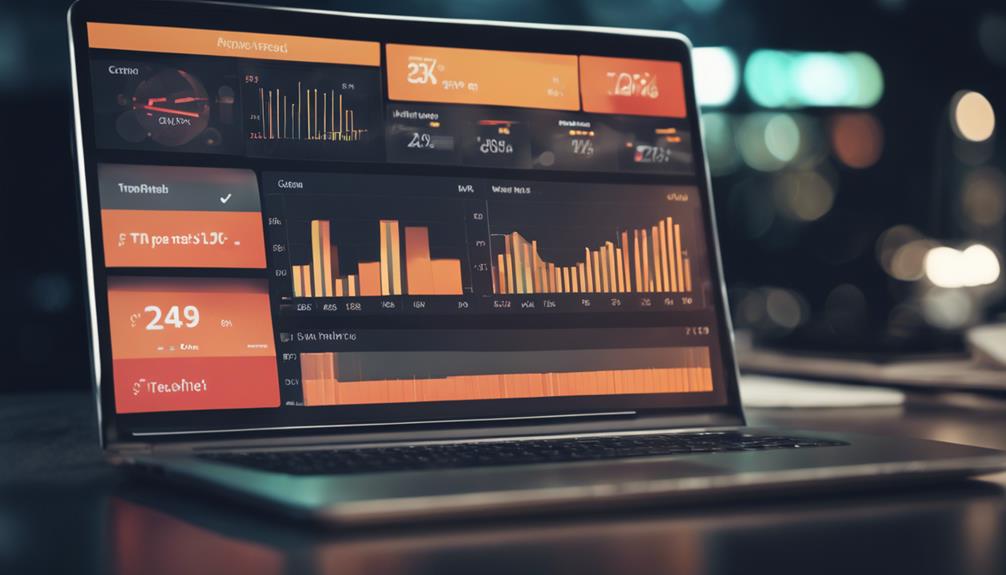Enhance payment services by utilizing predictive analytics to detect and prevent fraud effectively. Analyze customer behavior to tailor payment options and improve satisfaction. Optimize payment routing with cost and speed considerations. Forecast trends for better resource management. Automate decision-making processes to combat fraud efficiently. Focus on user satisfaction and engagement through personalized experiences. Tailor transaction notifications for increased engagement and reduced missed payments. Implement real-time risk assessment for enhanced security. Upgrade billing processes for optimized cash flow. Utilize advanced user authentication methods for increased security measures. Streamline reconciliation processes for efficient issue resolution. Discover more about optimizing payment services with predictive analytics.
Key Takeaways
- Implement advanced predictive analytics for fraud prevention and detection.
- Analyze customer behavior patterns for tailored services and targeted marketing.
- Optimize payment routing efficiency using payment analytics.
- Forecast payment trends with historical data and predictive models.
- Automate real-time payment decision-making for enhanced security and efficiency.
Fraud Detection and Prevention Strategies

To effectively combat fraud in payment services, implementing advanced predictive analytics tools is essential. Fraud detection and prevention are paramount in maintaining the integrity of financial transactions. Companies like Synchrony, Mastercard, and Visa have harnessed the power of predictive analytics to enhance their fraud prevention strategies successfully.
By utilizing predictive analytics, these companies can proactively identify potential fraudulent activities by analyzing patterns and trends in vast amounts of transaction data. Synchrony's AI and machine learning system, for instance, boasts an impressive detection rate of over 90%, substantially reducing false alarms and improving overall accuracy. Mastercard's tools, on the other hand, have been instrumental in preventing over $35 billion in fraud losses by identifying suspicious patterns indicative of fraudulent behavior.
Visa's widespread adoption of predictive analytics has also yielded impressive results, with a 30% reduction in fraud reported across thousands of financial institutions. These successes underscore the importance of leveraging predictive analytics in fraud prevention efforts, demonstrating its effectiveness in safeguarding financial systems and protecting consumers from fraudulent activities.
Customer Behavior Analysis for Insights

When analyzing customer behavior for insights, it's essential to identify behavior patterns and trends that offer valuable information.
By understanding how customers interact with payment options, businesses can tailor their services to meet specific needs effectively.
Utilizing predictive analytics to analyze behavior can lead to improved user experiences and increased customer satisfaction.
Behavior Patterns Identification
By utilizing predictive analytics, businesses can effectively identify behavior patterns in customer interactions for valuable insights. Customer behavior analysis enables the understanding of preferred payment methods, spending habits, and transaction frequencies. This analysis helps in offering tailored payment options that cater to individual preferences.
By recognizing these behavior patterns, businesses can anticipate customer needs, enhance service delivery, and boost user satisfaction. Insights gained from customer behavior analysis allow for targeted marketing strategies, customized loyalty programs, and engaging customer initiatives.
Applying predictive analytics to customer behavior not only optimizes payment services but also increases customer retention and drives business growth. Understanding these patterns is essential for providing a seamless payment experience and fostering long-term customer relationships.
Trend Analysis for Insights
How can trend analysis in predictive analytics provide valuable insights into customer behavior patterns and preferences?
By utilizing trend analysis, businesses can uncover valuable information about customer behavior, such as preferred payment methods and engagement levels. Understanding these patterns allows companies to tailor their services to meet customer needs effectively.
Analyzing customer behavior trends enables businesses to create targeted marketing strategies and personalized payment solutions, enhancing the overall customer experience.
By tracking customer behavior through trend analysis, businesses can optimize their payment services, leading to increased customer loyalty and satisfaction.
Ultimately, trend analysis in predictive analytics empowers businesses to make informed, data-driven decisions that drive improvements in their payment services and overall customer satisfaction.
Enhancing Payment Routing Efficiency

Looking to boost your payment routing efficiency with predictive analytics? By leveraging payment analytics, you can optimize payment processing and enhance transaction efficiency. Evaluating different payment options based on cost, speed, and availability allows you to choose the most effective payment gateway for each transaction. Monitoring market changes and adjusting your payment routing strategies accordingly guarantees that you maintain peak efficiency over time.
Utilizing data and algorithms to select the best payment processor for every transaction is crucial to improving overall routing efficiency. This strategic approach not only enhances transaction efficiency but also boosts your overall payment processing performance. By fine-tuning your payment routing processes, you can streamline operations, reduce costs, and provide a seamless payment experience for your customers. Stay ahead in the competitive payment services landscape by making informed decisions based on predictive analytics to drive efficiency and effectiveness in your payment routing strategies.
Forecasting Payment Trends Accurately

Accurately forecasting payment trends is vital for businesses to plan efficiently and optimize resource allocation. By leveraging payment data and predictive models, businesses can gain valuable insights into future transaction volume, enabling them to make informed decisions.
- Analyzing Payment Data: Examining historical payment data allows businesses to identify patterns and trends, assisting in the development of accurate predictive models.
- Utilizing Predictive Models: Implementing predictive models based on machine learning algorithms can help in forecasting spikes in transaction volume, facilitating better resource allocation and planning.
- Managing Transaction Volume: Anticipating fluctuations in transaction volume enables businesses to adjust their operations, cash flow, and inventory management strategies accordingly.
Forecasting payment trends not only assists in optimizing payment processing times but also plays an important role in anticipating potential issues and ensuring effective resource utilization. By harnessing the power of predictive analytics, businesses can stay ahead of the curve and make well-informed decisions for sustainable growth.
Automating Payment Decision-Making

To enhance efficiency in payment decision-making and mitigate fraud risks, consider implementing automated systems that analyze patterns and anomalies in real time. By utilizing data analytics tools, you can process information swiftly, outpacing manual review methods. These automated systems not only help in preventing payment fraud but also prompt customers to verify any unusual transactions, thereby reducing the likelihood of fraudulent activities. In the event of significant deviations, accounts can be instantly frozen to guarantee a rapid response to unauthorized transactions, safeguarding user accounts effectively.
Financial decision-makers must carefully select predictive analytics-based solutions to address fraud effectively and enhance payment security. The ability of these systems to analyze vast amounts of data in real time provides a proactive approach to combatting fraudulent activities and protecting both the organization and its customers. Implementing automated decision-making in payment services is essential in today's digital landscape to stay ahead of evolving fraud tactics and safeguard customer transactions.
Personalizing Payment Experiences for Users

When personalizing payment experiences for users, customized payment options and tailored transaction notifications become key components.
By analyzing user behaviors and preferences, predictive analytics can offer a more personalized and user-centric payment journey.
This tailored approach enhances user satisfaction and loyalty, ultimately creating a seamless payment experience that meets individual needs.
Customized Payment Options
Enhance user satisfaction and boost engagement by tailoring payment options to individual preferences. Providing customized payment methods based on user behavior not only increases customer satisfaction but also fosters loyalty. By offering personalized experiences such as preferred currencies, languages, and payment methods, you can enhance the overall user experience. This tailored approach guarantees that users feel valued and understood, ultimately leading to higher conversion rates and improved engagement with your payment services.
- Tailored payment methods cater to individual preferences
- Personalization based on user behavior boosts loyalty
- Offering preferred currencies, languages, and payment methods enhances user experience
Tailored Transaction Notifications
By tailoring transaction notifications based on predictive analytics, you can greatly enhance user engagement and satisfaction in payment experiences. Leveraging data to customize alerts allows for a more personalized approach, leading to increased customer interaction and contentment. Studies have shown that tailored notifications can boost customer engagement by up to 25%, while also resulting in a 30% higher satisfaction rate. Utilizing predictive analytics for transaction notifications not only enhances the user experience but also reduces missed payments by 15% and increases on-time payments by 20%. Moreover, customized alerts have proven to decrease customer churn rate by 10%, showcasing the significant impact of personalized transaction notifications on overall payment services.
| Benefits of Tailored Transaction Notifications | Statistics |
|---|---|
| Increase in customer engagement | Up to 25% |
| Higher customer satisfaction rate | 30% |
| Reduction in missed payments | 15% |
| Rise in on-time payments | 20% |
Implementing Real-Time Risk Assessment

Implementing real-time risk assessment in payment services involves leveraging predictive analytics to evaluate transactions instantly. By harnessing real-time data, risk management becomes proactive and adaptive, enhancing fraud detection capabilities. Machine learning algorithms play a pivotal role in this process, continuously analyzing vast amounts of transaction data to identify patterns and anomalies swiftly.
- Immediate Decision-Making: Real-time risk assessment allows for quick decisions on whether to accept, reject, or flag transactions for further review, ensuring prompt action to mitigate potential risks.
- Enhanced Accuracy: Predictive models leverage real-time variables alongside historical data to assign risk scores accurately, enabling precise identification of suspicious activities.
- Efficiency Boost: Utilizing machine learning and AI technologies not only improves the accuracy of risk assessment but also streamlines the process, leading to more efficient fraud detection mechanisms.
Improving Billing Process Through Analytics

Analyzing billing data allows you to identify patterns, predict payment trends, and streamline invoicing procedures efficiently.
By leveraging predictive analytics, you can anticipate billing cycles, avoid delays, and optimize cash flow management effectively.
Implementing these strategies can lead to cost savings, increased efficiency, and enhanced customer satisfaction through personalized billing experiences.
Billing Data Analysis
Enhance your billing process efficiency through insightful data analysis that uncovers payment trends and optimizes resource allocation for smoother transactions.
By leveraging analytics tools, you can gain valuable insights into transaction volumes and customer experience, allowing you to tailor your billing processes accordingly.
Analyzing billing data not only helps in identifying preferred payment methods and peak transaction times but also aids in forecasting cash flow, budgeting needs, and inventory management.
Understanding customer billing patterns through data analysis enables you to offer personalized billing options and promotions.
Additionally, this approach minimizes errors, optimizes processing times, and enhances overall billing efficiency, ensuring a seamless experience for both your business and your customers.
Payment Trends Prediction
To optimize your billing process through analytics, consider leveraging predictive analytics to anticipate payment trends and enhance resource allocation for improved efficiency.
Predictive analytics can forecast payment trends by analyzing customer payment preferences, habits, and transaction data. By examining historical payment data, you can predict future billing volumes, patterns, and customer behavior.
Machine learning algorithms play a vital role in identifying patterns in billing processes, ultimately improving efficiency and accuracy in forecasting payment trends. Utilizing predictive analytics in payment services enables proactive decision-making, leading to optimized billing strategies and enhanced customer satisfaction.
Streamlining Invoicing Procedures
Improving your invoicing procedures through analytics can lead to significant reductions in errors and increased efficiency. By leveraging predictive analytics, you can streamline your billing process and enhance your financial operations. Here are key benefits of utilizing analytics in invoicing:
- Predictive analytics can help identify customer payment patterns, allowing for proactive follow-ups on overdue invoices.
- Analyzing historical data enables businesses to forecast invoice volumes accurately, optimizing resource allocation.
- Streamlining invoicing procedures through analytics can result in up to 30% faster invoice processing times, ultimately improving cash flow and customer satisfaction.
Enhancing User Authentication Methods

User authentication methods are being enhanced through the utilization of biometric verification and multi-factor authentication for heightened security measures. Biometric authentication, such as fingerprints and facial recognition, offers an essential way to verify user identity.
Multi-factor authentication (MFA) combines various factors like passwords, tokens, and biometrics to add layers of security. Behavioral biometrics analyze user behavior patterns for continuous authentication, aiding in fraud detection. Adaptive authentication further strengthens security by adjusting measures based on risk levels and user behavior.
Predictive analytics plays a pivotal role in enhancing user authentication by predicting and preventing fraudulent access attempts through the analysis of historical and real-time data. By leveraging these advanced technologies, businesses can better protect transactions and user information, ultimately improving the overall security of payment services.
Streamlining Payment Reconciliation Processes

By leveraging predictive analytics, businesses can streamline their payment reconciliation processes efficiently and effectively. This technology allows for the matching and verification of transactions in a timely manner, ultimately improving accuracy and saving time.
Here are some key benefits of streamlining payment reconciliation with predictive analytics:
- Automated Matching: Predictive analytics tools automate the reconciliation process, reducing the likelihood of errors and ensuring a faster verification process.
- Quick Discrepancy Identification: These tools can analyze payment data swiftly to identify any discrepancies, allowing businesses to address issues promptly.
- Enhanced Financial Operations: By utilizing predictive analytics for payment reconciliation, businesses can maintain robust data records, leading to improved customer satisfaction and operational efficiency.
Frequently Asked Questions
How Can Predictive Analytics Be Used in Finance?
Predictive analytics in finance improves fraud detection, reducing losses considerably. Tools like Mastercard and Visa use predictive models to prevent billions in fraudulent activities.
Automation processes data faster than manual methods, enhancing fraud prevention capabilities. By leveraging predictive analytics, financial institutions can implement additional protective measures against fraudulent transactions, ensuring a more secure payment environment.
How Is Predictive Analytics Used in Banking?
In banking, predictive analytics is utilized to assess credit risk, detect fraud, segment customers, and predict behavior. These analyses help optimize services, enhance satisfaction, and retain customers.
Why Is Payment Analytics Important?
Payment analytics is essential for understanding customer preferences, behaviors, and trends. It provides insights into transaction details and purchasing habits. Decision-making for staffing, expanding payment options, and marketing is enhanced.
Tracking metrics like payment types and chargeback rates improves operational efficiency. Analyzing payment trends and customer loyalty boosts engagement and informs business strategies. Payment analytics is indispensable for optimizing services and staying competitive in the market.
What Is Predictive Modeling in Finance?
Predictive modeling in finance involves using data to forecast future trends and behaviors. It analyzes patterns through statistical algorithms and machine learning. This helps institutions make informed decisions on risk, fraud, and investments.
Conclusion
To sum up, implementing predictive analytics in payment services can greatly improve efficiency and security.
While some may argue that the initial investment is high, the long-term benefits far outweigh the costs.
By detecting fraud, analyzing customer behavior, and streamlining processes, businesses can enhance user experience and increase profitability.
Embracing predictive analytics is the key to staying ahead in the ever-evolving payment industry.










